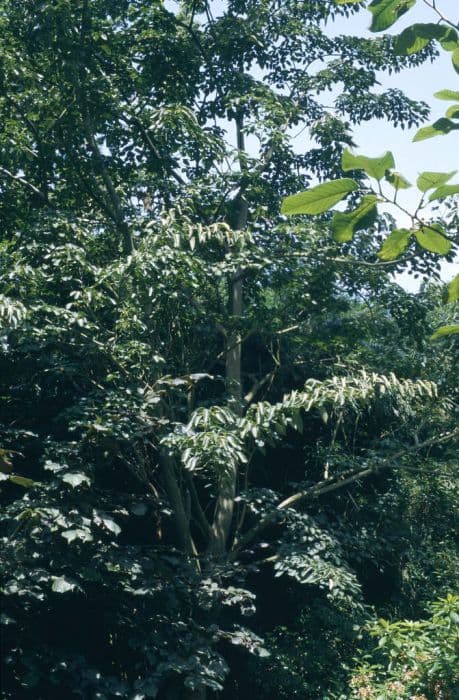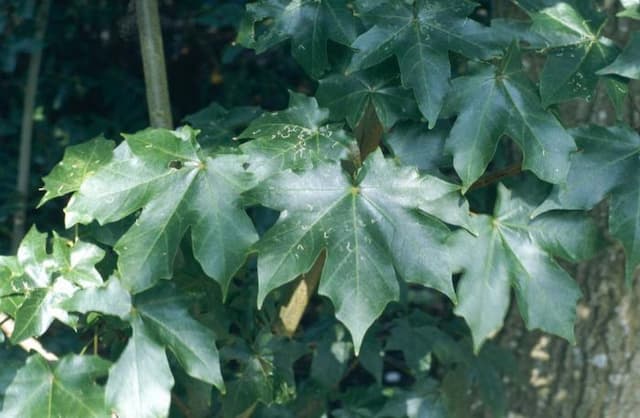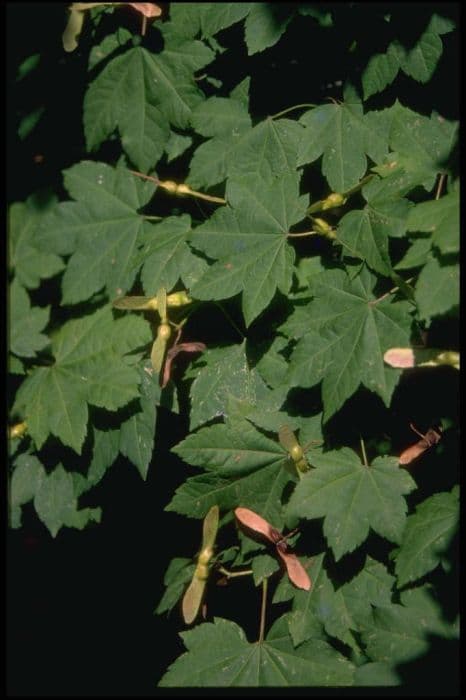Yellow buckeye Aesculus flava

ABOUT
A. flava is a large deciduous tree with spreading crown. Leaves divided into 5-7 leaflets, turning red or yellow in autumn. Flowers yellow, in erect racemes, followed by smooth, rounded fruit
About this plant
 Names
NamesSynonyms
Yellow Buckeye, Sweet Buckeye, Yellow Horse Chestnut.
Common names
Aesculus octandra, Aesculus flava var. flava, Aesculus flava var. purpurascens, Aesculus flava var. vestita.
 Characteristics
CharacteristicsLife cycle
Perennials
Foliage type
Deciduous
Color of leaves
Green
Flower color
Yellow
Height
50-75 feet (15-23 meters)
Spread
40-50 feet (12-15 meters)
Plant type
Tree
Hardiness zones
4
Native area
Southeastern United States
Benefits
 General Benefits
General Benefits- Shade Provider: Aesculus flava, commonly known as the yellow buckeye, grows into a large tree that offers ample shade, making it suitable for parks, large gardens, and open landscapes.
- Landscape Aesthetics: With its showy yellow flowers that bloom in spring, the yellow buckeye enhances the visual appeal of landscapes and gardens.
- Wildlife Habitat: It serves as a habitat and food source for various wildlife species, including squirrels and birds that eat its seeds.
- Soil Stabilization: The tree's extensive root system helps to stabilize soil and prevent erosion, particularly in hilly or uneven terrains.
- Educational Interest: Yellow buckeye can be used in educational settings like arboretums and botanical gardens to teach about native tree species and biodiversity.
- Seasonal Interest: Apart from its spring flowers, the tree offers seasonal interest with its rich green summer foliage and yellow to orange fall color, providing year-round visual interest.
 Medical Properties
Medical Properties- Anti-inflammatory: Yellow buckeye has been used in traditional medicine for its potential anti-inflammatory properties.
- Analgesic: It may have been used to relieve pain.
- Venous Insufficiency: The seeds of yellow buckeye, like those of its relative Aesculus hippocastanum, may be beneficial in treating chronic venous insufficiency, although clinical evidence is limited.
- Topical Application for Skin Issues: Poultices made from yellow buckeye have historically been used for skin ulcers and sores.
 Air-purifying Qualities
Air-purifying QualitiesThis plant is not specifically known for air purifying qualities.
 Other Uses
Other Uses- The wood of the yellow buckeye is often used for making paper, offering an alternative fiber source for the paper industry due to its fibrous bark and wood.
- Yellow buckeye seeds have been utilized as a laundry detergent substitute in the past because they contain saponins, natural soap-like substances.
- In carpentry, the lightweight and weak wood can be employed for making crates, pallets, or other items where strength is not a primary concern.
- The tree's tannin-rich bark has been used for tanning leather, although it's not as commonly used as tannins from other trees.
- Yellow buckeye is used in landscaping and urban plantings for its showy spring flowers and its ability to provide dense shade.
- The seeds, sometimes called "buckeyes," have been traditionally carried as a good luck charm in some cultures.
- Children have used the smooth, shiny seeds for various games and crafts, including necklace-making and other jewelry.
- During certain historical periods, the crushed seeds of yellow buckeye were used as a fish stupefier, making fish easier to catch by hand or with nets.
- The greenish-yellow flowers can serve as a source of nectar and pollen for bees and other pollinators in the spring.
- In woodturning and amateur woodworking, the relatively soft wood of the yellow buckeye can be an appealing choice for practicing and creating non-durable items.
Interesting Facts
 Feng Shui
Feng ShuiThe Yellow Buckeye is not used in Feng Shui practice.
 Zodiac Sign Compitability
Zodiac Sign CompitabilityThe Yellow Buckeye is not used in astrology practice.
 Plant Symbolism
Plant Symbolism- Strength: The Yellow Buckeye (Aesculus flava) is known for its hardy nature and resilience, symbolizing inner strength and the ability to withstand challenges.
- Protection: With its vast canopy and sturdy trunk, the Yellow Buckeye is often seen as a symbol of protection, offering shelter and safety.
- Endurance: Given its long lifespan and ability to persist in various conditions, the Yellow Buckeye represents the endurance needed to persevere through hard times.
- Prosperity: Buckeye nuts were carried as good luck charms, suggesting that the Yellow Buckeye is a symbol of prosperity and potential financial success.
- Wisdom: In some traditions, trees are widely respected as ancient beings. The Yellow Buckeye, with its durable wood and presence in the forest, can be a symbol of wisdom and knowledge.
 Water
WaterThe Yellow Buckeye (Aesculus flava) should be watered deeply to encourage a strong root system, which often means providing about 1 to 1.5 gallons of water per week during its growing season, though this can vary depending on soil type and climate. It's essential to adjust watering for rainfall and not to waterlog the soil, as standing water can lead to root rot. During dry spells, additional water may be necessary, while in periods of heavy rain, you can skip watering altogether. During winter, when the tree is dormant, water less frequently, providing just enough to keep the soil from drying out completely.
 Light
LightThe Yellow Buckeye prefers full sun to partial shade. It thrives best in a spot where it can receive at least four to six hours of direct sunlight daily, though it can tolerate some shade. The ideal location for a Yellow Buckeye is somewhere that receives morning sun followed by dappled afternoon shade, especially in hotter climates to prevent leaf scorch.
 Temperature
TemperatureThe Yellow Buckeye is hardy and can withstand a range of temperatures, generally thriving in USDA hardiness zones 4 through 8. The plant can survive minimum temperatures as low as -30°F and can handle the summer heat well. The ideal temperature range for this tree would be between 50°F and 85°F for optimal growth.
 Pruning
PruningPrune the Yellow Buckeye to remove dead or broken branches, shape the tree, and encourage healthy growth. The best time for pruning is late winter or early spring before the new growth starts. Typically, pruning should be done annually to maintain shape and structural integrity, but excessive pruning should be avoided to allow the tree to develop its natural form.
 Cleaning
CleaningAs needed
 Soil
SoilYellow Buckeye thrives best in moist, well-drained soil with a pH of 6.0-7.5. A mixture of loam, peat, and some sand is ideal to replicate the natural habitat and to ensure good drainage and aeration.
 Repotting
RepottingYellow Buckeye trees, being large, are not typically repotted. In landscape use, they're planted with ample room to grow, so they don't require repotting.
 Humidity & Misting
Humidity & MistingYellow Buckeye does not require specific humidity conditions; it adapts well to outdoor ambient humidity in its growing regions.
 Suitable locations
Suitable locationsIndoor
Not suited for indoor growth; requires ample space.
Outdoor
Plant in moist, well-drained soil; full sun to partial shade.
Hardiness zone
4-8 USDA
 Life cycle
Life cycleThe Yellow Buckeye (Aesculus flava) begins its life cycle when its seeds, large shiny brown nuts enclosed in a leathery capsule, germinate after a period of cold stratification. The seedlings develop into saplings with compound leaves spreading out from a central stem. As the tree matures, it develops a thick trunk with a gray to brown bark and a rounded to broad-spread crown, usually reaching considerable heights of up to 30 meters. Seasonally, the Yellow Buckeye produces panicles of yellow to greenish-yellow flowers in the spring, which are pollinated by insects, primarily bees. Following pollination, the tree bears fruit in the form of prickly capsules, each containing 1 to 3 seeds, which fall to the ground in autumn. The Yellow Buckeye can live for many years, during which it goes through a period of growth, flowering, and seed set annually, contributing to forest regeneration and serving as a habitat and food source for wildlife.
 Propogation
PropogationPropogation time
Spring to summer
Propogation: The most popular method of propagation for the Aesculus flava, commonly known as the yellow buckeye, is through seed germination. The best time to collect seeds is in the autumn when they fall naturally from the tree. It is essential to plant them immediately, as the seeds have a short viability period and drying out reduces germination rates. Seeds should be sown outdoors in a well-drained soil at a depth of about 1 inch (2.54 cm). The seeds require a period of cold stratification to break dormancy, which can be provided naturally by the winter conditions if planted outdoors. Alternatively, stratification can be done artificially by storing the seeds in a refrigerator for approximately 2-3 months before planting. Once stratified, the seeds will typically germinate in the spring as temperatures rise.









